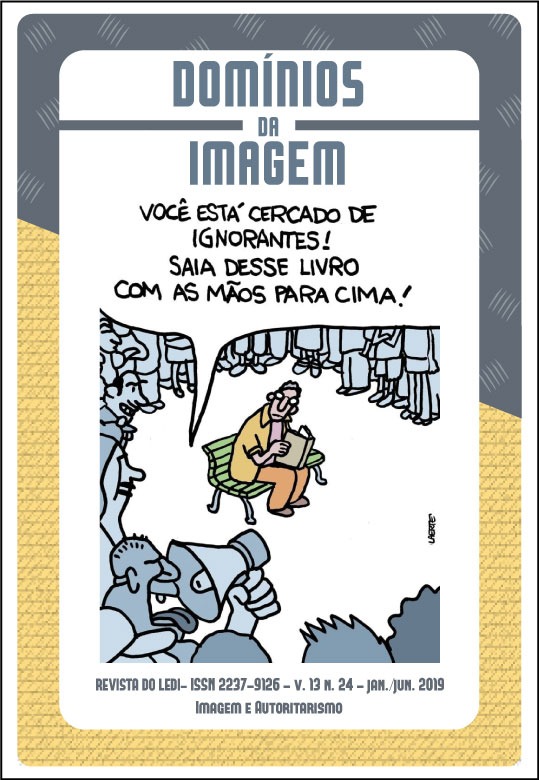The ogre and the demon: the photographic representaton of the nuclear devastation in “Hiroshima”, by Ken Domon (1945-1958)
DOI:
https://doi.org/10.5433/2237-9126.2019v13n24p30Keywords:
Ken Domon, Hiroshima, Photograph.Abstract
In 1958, Japanese photographer Ken Domon (1909-1999) published a collection titled “Hiroshima”, in which produced iconic-discursive narratives on the victims of the atomic bomb launched by US army in the homonymous city. This paper intends to analyze texts and photographs present in the book, having as temporal delimitation the period of 1945 and 1958, marked, respectively, by the nuclear attack and the publication of “Hiroshima”. From a theoretical and methodological point of view, the images are conceived as representations composed of photographic signs, whether thought as units, whether articulated to other photographs and even texts. As results, it is suggested that the collection, using humanizing approach and highlighting the stories of people whose lives were affected by the atomic bomb, was published with the intention of not allowing the sufferings derived from the war to be forgotten, precisely at a time when Japanese society began to show signs of prosperity and accelerated economic growth.Downloads
References
BARTHES, Roland. A câmara clara: nota sobre a Fotografia. Lisboa: Edições 70, 2010. BARTHES, Roland. O óbvio e o obtuso: ensaios críticos III. Rio de Janeiro: Nova Fronteira, 1990.
CASTILHO TRONCOSO, Alberto del. Las mujeres de X’oyep. México: Conaculta; Cenart; Centro de la Imagen, 2013. CHARTIER, Roger. À beira da falésia: a História entre certezas e inquietudes. Porto Alegre: Ed. Universidade; UFRGS, 2002.
COLE, Emily Elizabeth. Towards a new way of seeing: finding reality in postwar Japanese photography, 1945-1970. Thesis (Master of Arts) – Department of History and Graduate School of the University of Oregon, Oregon. 2015.
DOMON, Ken. Boku no bunshin toshite. In: DOMON, K. Koji junrei. Tôkyô: Kabushiki Kaisha Shôgakukan, 1998a. p. 273-274.
DOMON, Ken. Boku no sukina mono. In: DOMON, K. Koji junrei. Tôkyô: Kabushiki Kaisha Shôgakukan, 1998b. p. 270-272.
DOMON, Ken. Chikuhô no kodomotachi: Ken Domon shashinshû. Tôkyô: Patoria shoten, 1960.
DOMON, Ken. Domon Ken shashin ronshû. Tôkyô: Tsukiji Shokan, 2016a.
DOMON, Ken. Fubo - Visager: Portraits by Domon Ken. Tôkyô: ARS, 1953.
DOMON, Ken. Hashiru butsuzô. In: DOMON, K. Koji junrei. Tôkyô: Kabushiki Kaisha Shôgakukan, 1998c. p. 285-285.
DOMON, Ken. Hôon. In: DOMON, K. Koji junrei. Tôkyô: Kabushiki Kaisha Shôgakukan, 1998d. p. 291-292.
DOMON, Ken. Ikite iru Hiroshima. Tôkyô: Tsukiji Shokan, 1978.
DOMON, Ken. Koji junrei. In: DOMON, K. Koji junrei. Tôkyô: Kabushiki Kaisha Shôgakukan, 1998e. p. 290-291.
DOMON, Ken. Koji junrei. Tôkyô: Kabushiki Kaisha Shôgakukan, 1998f. DOMON, Ken. Oni no manako: Domon Ken no shigoto. Kyôto: Mitsumura Suiko Shoin Publishing, 2016b.
DOMON, Ken. Shinu koto to ikiru koto. Tôkyô: Tsukiji Shokan, s.d. DOMON, Ken. Watashi no rirekisho yori. In: DOMON, K. Koji junrei. Tôkyô: Kabushiki Kaisha Shôgakukan, 1998g. p. 287-288. WORLD WAR II MULTIMEDIA DABATASE. Disponível em: https://worldwar2database.com/gallery/wwii1116. Acesso em: 17 jul. 2019. 2. Bibliografia ADAMS, Ansel. A câmera. 3. ed. São Paulo: Editora SENAC, 2003. 64
DUBOIS, Philippe. O ato fotográfico e outros ensaios. 7. ed. Campinas: Papirus, 1993. EHRLICH, Linda C. Erasing and refocusing: two films of the occupation. In: SANDLER, Mark (Ed.). The confusion era: art and culture of Japan during the Allied Ocupation, 1945-1952.
FUJII, Masao. Maintenance and change in Japanese traditional funerals and death-related behavior. Japanese journal of religious studies, v. 10, n. 1, p. 39- 64, 1983.
IGARASHI, Yoshikuni. Bodies of memory: narratives of war in postwar Japanese culture, 1945-1970. New Jersey: Princeton University Press, 2000.
JAFFE, Richard M. Introduction. In: SUZUKI, Daisetz T. Zen and Japanese culture. Princenton: Princenton University Press, 2010. s.p.
KUROSAWA, Akira. Os homens que pisaram na cauda do tigre. 1945. Filme (58 min.): sonoro, preto e branco, áudio em japonês. KUROSAWA, Akira. Rapsódia em agosto. 1991. Filme (98 min.): sonoro, colorido, áudio em japonês.
LUIZ, Leonardo Henrique. O espírito de Yamato: o Xintoísmo de Estado e o Kyoiku Chokugo na formação do nacionalismo japonês e a imigração para o Brasil (1890-1980). Dissertação (Mestrado em História Social) – Universidade Estadual de Londrina, Londrina. 2019. 65
ANDRÉ, Richard Gonçalves. O ogro e o demônio: a representação fotográfica da devastação nuclear em "Hiroshima”, de Ken Domon (1945-1958). Domínios da imagem, v. 13, n. 24, p. 30- 65, jan./jun. 2019.
MACHADO, Arlindo. A ilusão especular. São Paulo: Editora Brasiliense, 1984.
MCDONALD, Keiko I. Whatever happened to passive suffering? Women on screen. In: SANDLER, Mark (Ed.). The confusion era: art and culture of Japan during the Allied Ocupation, 1945-1952. Seattle; London: Arthur M. Sackler Gallery; University of Washington Press, 1997. p. 53-71.
MUNROE, Alexandra. Postwar Japanese photography and the pursuit of consciousness. In: Daido Moriyama: stray dog. S.l: s.e, s.d.
OKAZAKI, Tetsuji. Strategies and organizations for managing “Greater East Asia Co-Prosperity Sphere”. Tokyo: The University of Tokyo, 2013.
OSTROWER, Fayga. Universos da arte. 3. ed. Rio de Janeiro: Editora Campus, 1986. PELLEGRINO, Charles R. The last train from Hiroshima. New York: Henry Holt and Company, 2010.
RAMBELLI, Fabio. Home buddhas: historical processes and modes of representation of the sacred in the Japanese Buddhist family altar (butsudan). Japanese religions, v. 35, n. 1/2, p. 63-86, [s.d.].
RICHIE, Donald. The occupied arts. In: SANDLER, Mark (Ed.). The confusion era: art and culture of Japan during the Allied Ocupation, 1945-1952.
Seattle; London: Arthur M. Sackler Gallery; University of Washington Press, 1997. p. 11-21.
Seattle; London: Arthur M. Sackler Gallery; University of Washington Press, 1997. p. 39-51. FELTENS, Frank. “Realist” betweenness and collective victims: Domon Ken’s Hiroshima. Stanford journal of East Asian affairs, v. 11, n. 1, p. 64-74, 2011.
SHIBASAKI, Atsushi. Activities and discourses on international cultural relations in modern Japan: the making of KBS (Kokusai Bunka Shinko Kai), 1934-1953. In: HERREN, Madeleine (Ed.). Networking the international system. Switzerland: Springer International Publishing, 2014. p 53-72.
SONTAG, Susan. Ensaios sobre fotografia. Rio de Janeiro: Arbor, 1981. VIEIRA, José Rodolfo. Representações das mulheres palestinas na perspectiva do jornalista estadunidense Joe Sacco durante a primeira intifada (1992-1996). Domínios da imagem, v. 11, n. 21, p. 117-140, jul./dez. 2017.
WARREN, Lynne (Ed.). Photography in Japan. In: WARREN, L. Encyclopedia of twentieth-century photography. New York; London: Routledge, 2006. YAMAGISHI, Shoji. Introduction. In: SZARKOWSKI, John; YAMAGISHI, S. (Ed.). New Japanese photography. New York: The Museum of Modern Art, 1974. p. 11-12
Downloads
Published
How to Cite
Issue
Section
License
Domínios da Imagem adopts the Creative Commons Attribution 4.0 International License, therefore, the copyrights related to the published articles belong to the author(s), who grant the journal the exclusive right of first publication.
Under this license it is possible to: Share - copy and redistribute the material in any medium or format. Adapt - remix, transform, and build upon the material, giving due credit and providing a link to the license and indicating if changes were made.











 The works in this journal are licensed under Creative Commons .
The works in this journal are licensed under Creative Commons .